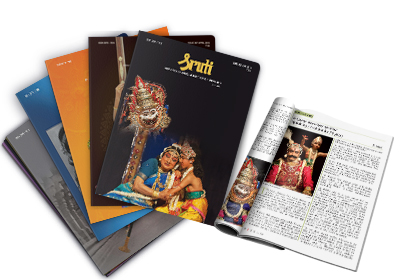
Editor-in-Chief N. PATTTABHI RAMAN, assisted by INDU VARMA, probed the mind of Sudharani Ragupathy during two interview sessions.
You have said: “Once a dancer, always a dancer.” Would you care to explain.
As a child I seem to have displayed a natural liking for dance. It was a child’s play, in a manner of speaking, but my mother and some of her friends seem to have thought I had an aptitude for dancing. Even though my father did not think much of it, my mother fixed up teachers for me and I learnt Bharatanatyam. If I had been born and raised in the North, presumably I might have ended up learning Kathak. Or, if I had not been encouraged to learn and perform dance, I might possibly have taken to writing poetry. Or I might have become a painter. I was good at it too. There was an element of chance in my becoming a dancer.
Success breeds success. I guess I became deeply involved with the dance even as a young girl as each performance led to another.
But in your case, you chose matrimony over a career in dance.
Yes, I did. It was a very practical choice, given the fact that dance did not then enjoy the respectability it does today. But deep down in my heart, I loved dance.
Are you happy you were able to resume dancing? You have done very well for yourself….
Yes. Dance has become a part of my life, in fact central to my life. In my experience, it involves body, mind and soul. It is a medium that helps one to experience -- and express -- the beautiful things of life. It is an aspect of our culture where art, religion and philosophy blend.
As an art, Bharatanatyam is a composite of dance, music, sculpture, poetry, rhythm, colour and facial expression. To learn it and perform it is a wonderful way to experience all these aspects.
I enjoy dancing, being involved in dance. Furthermore, when I take a step and draw people to me, it gives me satisfaction, contentment.
In a lecture you delivered several years ago, you said dance is an important branch of art in which man’s inner emotions find systematised expression and manifestation.
Yes, I said that and I believe that to be true. God is Truth and Beauty. Dance creates beauty, the image of the Infinite.
In the West, dance has come to be regarded as a means of self-expression, an expression of the artist’s individual personality. On the other hand, in the East, in India particularly, the conception of art is that it represents an interpretation of the ideal and the Universal and the sublimation of ideas by the effacement of the individual personality through well defined traditional codes, conventions, symbols and techniques.
In this conception, the art of dancing is a pathway to a trans-mundane experience. Its purpose is in the main spiritual. The dancer uses not only her feet but also her imagination to convey the true meaning of dance, the meaning of life itself.
All this sounds far removed from reality….
Well, maybe. Commercial instincts predominate today, but the ideal must always be kept in view. Those who understand the true purpose of art must keep underlining it. I am an optimist and I like to believe that the younger generation of dancers, at least those who apply their mind to what they do, will be guided by the ideal.
You have contrasted the Western perception of art, in which the individual ego is central, with the Hindu concept in which the dancer is expected to sublimate herself. Do you really believe that ego plays no role in inspiring a dancer to add something of her own perception to what she has received through learning, to modify or replace handed down ideas?
I am not denying that ego plays a role, but I am saying from experience that the great moments of art, which are often fleeting, result when an inspired performer forgets the self while on the stage. As a dancer I need an audience, but even then I dance for myself. I cannot, I should not, step out of myself to see how I am performing and ask whether I am pleasing the audience. I cannot get involved in the dance if I do that.
Talking of rasanubhava, I want you to answer a question from your experience. Let us say you are performing an item which has a divine theme. What is it that moves you or the audience? Is it bhakti or art?
Both.
In what way is it both? For example. In ‘Taye Yasoda’, is there the bhakti element?
You have raised a valid question, but the problem is that it is not easy to describe the meaning of bhakti. I think bhakti is a personal experience which is above the mundane, an elevated experience of the soul.
In the example I have cited, what is it that moves the audience, is it bhakti whichever way you define it, or aesthetic experience as postulated in the theory of rasa?
It is the aesthetic quality of the dance.
So, even a dance which has no explicit bhakti element in it can produce rasanubhava?
Yes, it can.
But you have said that you don’t believe in art for art’s sake, haven’t you?
Yes, but I would like to respond to your implied question in two ways. One is that, personally, I do not dance for money. God has kept me above want. Whatever I am paid, I distribute among the artists who provide me accompaniment. If there’s something left over after this distribution, I use it to help poor students.
The other is that, in line with the Hindu concept, I believe art is a means to an end, but not a selfish end, though. I believe that art should aim at producing transcendental bliss, or what I might call spiritual satisfaction.
Do you make a distinction between music or dance as an instrument for promoting the bhakti marga, and music or dance as an art-form for providing aesthetic satisfaction? Is there no difference, for instance, between a bhajana session and a music concert, or between a Harikatha and a music concert?
I understand what you mean. One can have an elevating emotional experience through dance even in the absence of bhakti in the sense of devotion to god.
The artist has to sublimate her ego in order to obtain, or give to sahridaya-s in the audience, what is called rasanubhava, or aesthetic relish. Does this perception mean that, while the ego is necessary as a stimulant, it should be sublimated during performance, or rather that there is aesthetic relish only when there is self-effacement on the part of the performer?
I used the word self-effacement to refer to the condition which results from the full involvement of the dancer with what she is performing. An artist can achieve sublimation despite her ego, so long she loses herself in the act of performing.
Tell us about the ideas and experiences that have played a significant role in moulding you as an artist?
First, I should mention that I was brought up in an environment in which stories from epics and mythology were told and retold vividly, highlighting moral issues and philosophical ideas. Though I have been exposed to other concepts and philosophies of other religions, I have remained a product of our own culture and civilization.
Second, the Hindu conception of art and its purpose has been a tremendous influence on me. Although I am acquainted with the ideas of the West in this regard, I totally subscribe to the Hindu conception.
Do you share the view that dance is a visualisation of music?
Yes, I do. Most certainly. If one learns dance from a guru who is also a good musician, it helps to add poetry to the dance. The dance becomes the one whole which Abhinavagupta constantly speaks of in his commentary.
Do you think the younger dancers need to be given training on how to present a programme, with an eye to creating a wholesome impact?
Yes, I think such training will help. I studied this aspect at Randolph-Macon College in the U.S. and gained valuable insights. For example, how make-up should be varied for different skin tones. Eleanor Struppa of this college told me – this was 33 years ago -- that some skins reflect light and some don’t, and that if a skin reflects light, it must be toned down.
How about lighting?
I believe a Bharatanatyam performance does not require too much juggling with the lights. The basic bright light is enough. It is different for dance-drama, though.
How many dancers today have it in them to visualise the total effect their programmes must create? Or take into account, besides music, costumes and jewellery, stage decor, the quality of sound amplification, lighting and compering?
I guess many dancers who are educated have the eye, knowledge and experience to articulate all these aspects. but they need help from their teachers and from the organisers as well.
I think dance is so commercialised today that when a dancer gets an opportunity to dance, she wants to make the best use of it to establish herself as a popular performer. All thoughts of dance as an instrument to try and create rasanubhava get pushed to the background.
Would you like to sum up what dance has taught you?
As I said before, dance involves the body as well as the soul. Intellect, emotion, imagination all come into play. It can make the person who pursues it sincerely more gentle, more aware of the environment, react in the right way to external stimuli, be more aesthetic in outlook--in short be a very cultured person.
Dance, like music and other arts, helps us rise above the beast in ourselves.



